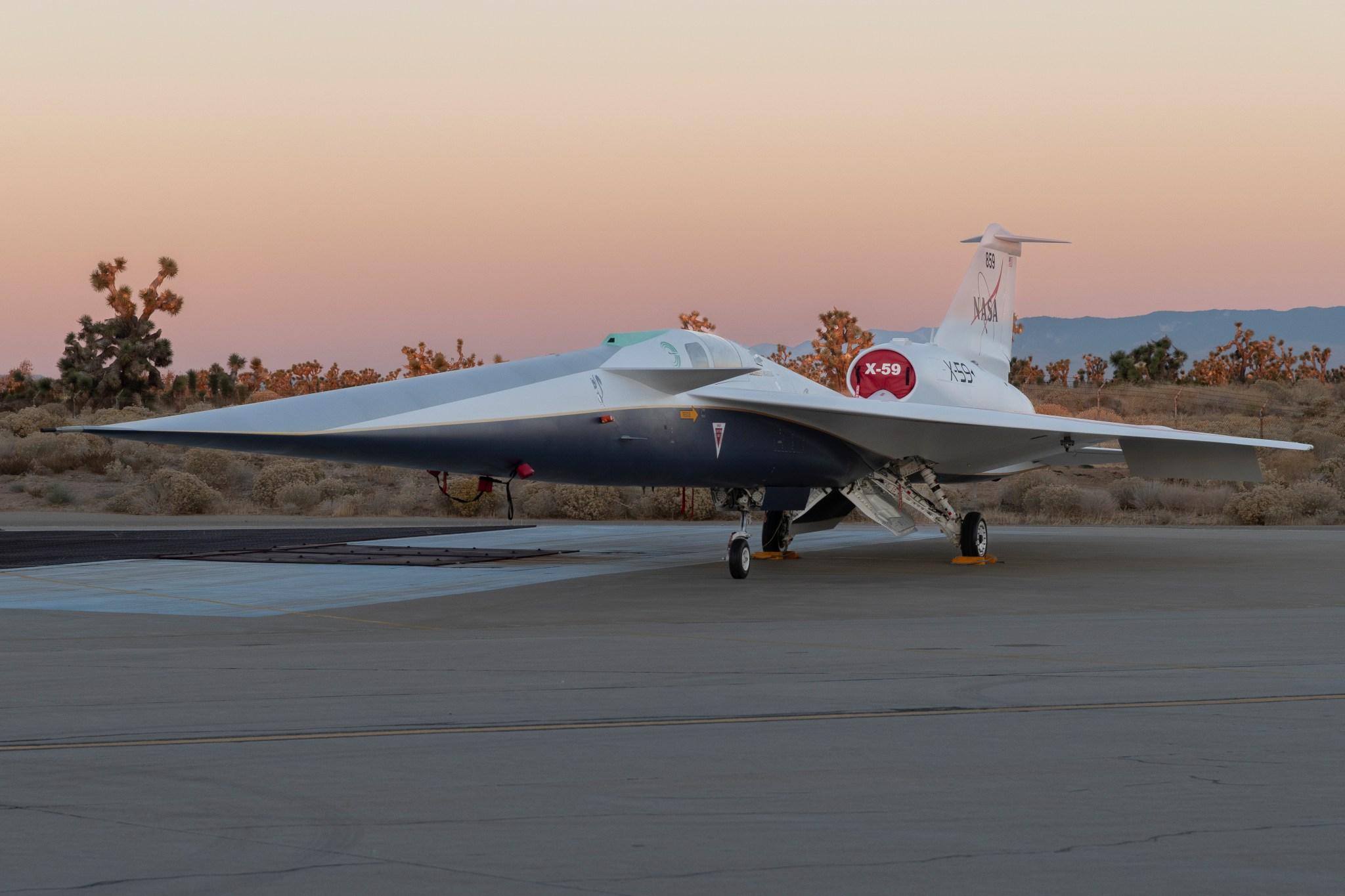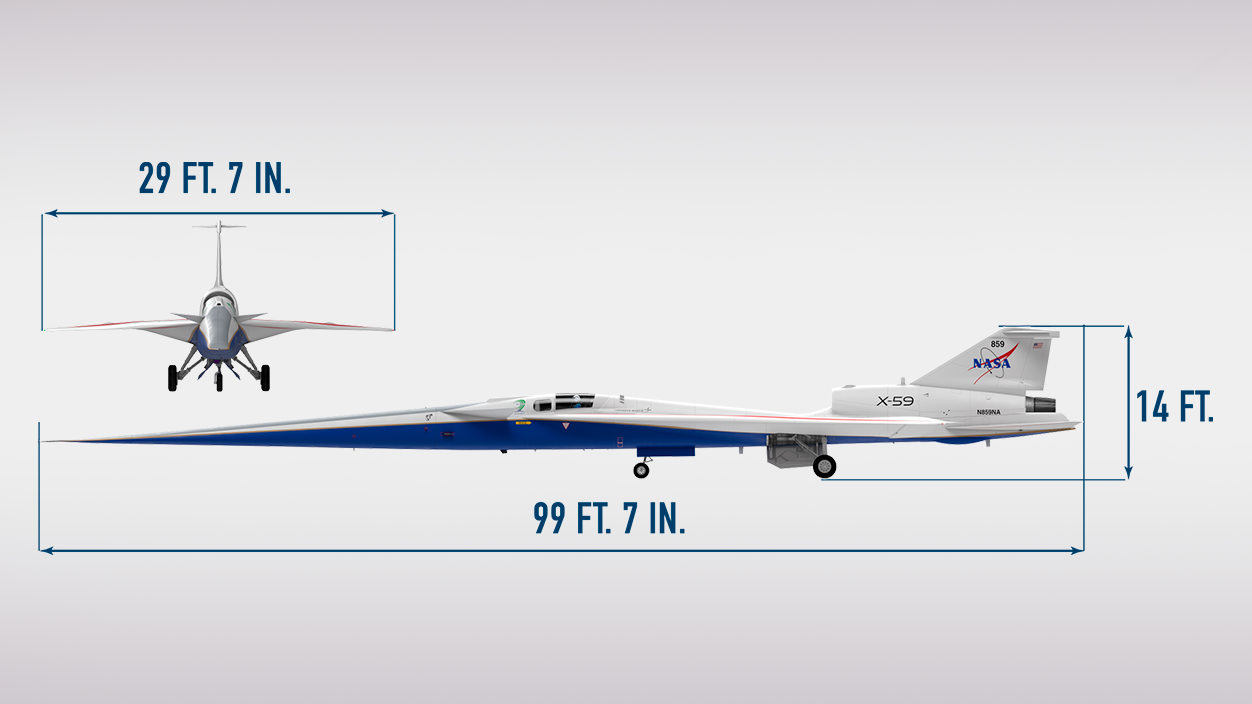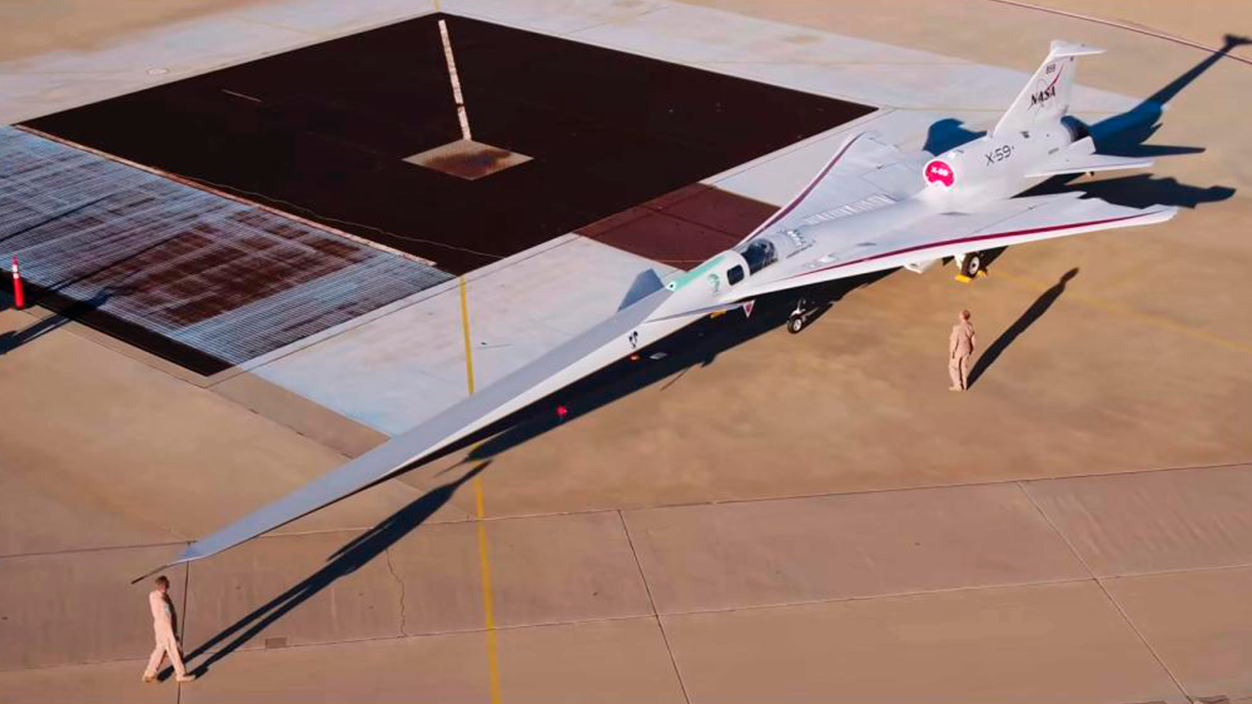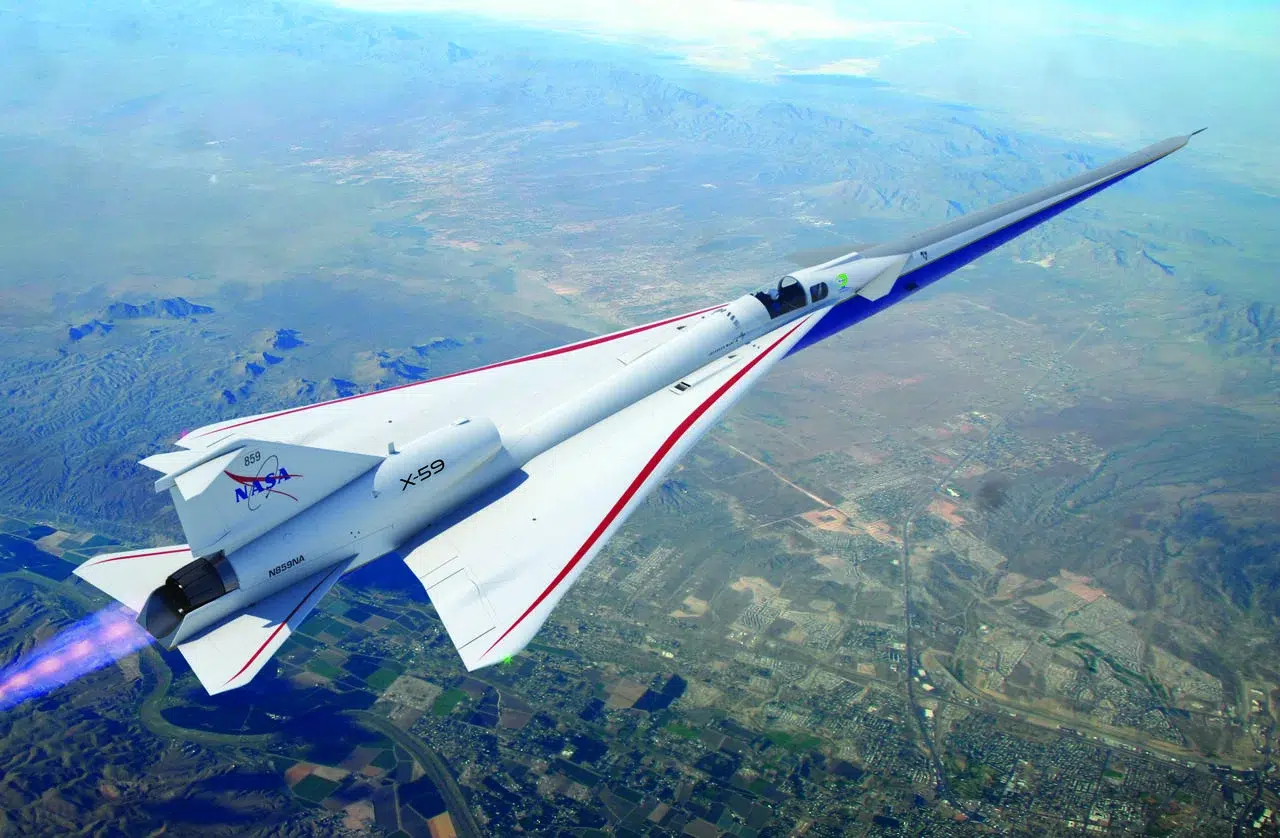- NASA and Lockheed Martin's X-59 completes its first test flight in California after years of development.
- Its "quiet supersonic" design seeks to transform the sonic boom into a smooth, controlled sound.
- The Quest program aims to gather data on public reaction and change regulations that prohibit supersonic flights over land.
- The technology could cut flight times between Europe, the United States and other intercontinental destinations in half.

The sunrise in Southern California has become the setting for one of the most striking milestones in recent aviation: the First flight of the X-59, the quiet supersonic aircraft from NASA and Lockheed MartinWith an elongated silhouette and an extremely thin nose, this experimental prototype has taken to the air for the first time with a very specific objective: to demonstrate that it is possible to fly faster than the speed of sound without the noise that has historically accompanied this type of aircraft.
This initial flight, lasting just over an hour, has confirmed that The aircraft's structure, onboard systems, and controls are functioning as expected.For the US space agency, the X-59 is not just a flashy aircraft, but the centerpiece of a mission that, if all goes well, could change the regulations for supersonic flight over populated areas in the United States, Europe and the rest of the world.
A different kind of jet: goodbye to the sonic boom
Since the mid-20th century, the major obstacle to commercial supersonic flight has been the boom or sonic boom that occurs when the sound barrier is brokenThat explosion, caused by the merging of shock waves around the aircraft, is not just an annoying noise: it can cause intense vibrations, make windows rattle, and generate all sorts of complaints on the ground, to the point of prompting Explicit prohibitions on supersonic flights over land in countries like the United States.
The Concorde, an icon of 20th-century civil aviation, was the clearest example of these limitations. It flew at breakneck speeds between Europe and America, but He could only take advantage of his supersonic capabilities over the ocean.far from cities. This restriction, combined with costs and operational problems, eventually led to its withdrawal from service in 2003, leaving a gap in high-speed transport.
The X-59 was created precisely to address that problem. NASA and Lockheed Martin have designed a aircraft designed from scratch for drastically reduce the acoustic impact of supersonic flightThe idea isn't so much to go faster than anyone else, but to achieve when breaking the sound barrier, instead of a bang comparable to an explosion, on land it is only perceived a dull thud or a "gentle tap", as described by the company itself.
Hence the internal nickname for the technology incorporated in the device: quiet supersonic, supersonic silentIf this approach works, authorities could revise rules that have for decades barred high-speed commercial flights over densely populated areas, including large parts of Europe.
Extreme design to tame shock waves

To achieve this highly controlled acoustic effect, the engineers have opted for a very unconventional designThe X-59 is about 30 meters long but has a wingspan of just 8,9 meters and a long, thin, and pointed fuselageIt resembles an aerodynamic pencil more than a typical passenger plane. This geometry is not merely an aesthetic whim: every centimeter of the structure has been calculated to shape the behavior of shock waves.
El extremely long and sharp snout It is responsible for "preparing" the air long before it reaches the rest of the fuselage, dividing and staggering the shock waves instead of allowing them to coalesce into a single powerful wave front. thin wings and finely tuned control surfaces They also contribute to the disturbances being distributed gradually, so that the sound that reaches the ground is more like a muffled blow than a detonation.
Another striking aspect is that the X-59 is not an aircraft created entirely from scratch. Lockheed Martin has decided take advantage of components already tested in fighter jets like the F-16 and F-15This involves, for example, integrating a landing gear from the F-16 and life support systems from existing military platforms. Combining proven components with new technologies reduces risks and allows efforts to be focused on the truly innovative aspect: supersonic noise control.
According to data provided by the program itself, The X-59's design cruising speed is Mach 1,4, which is equivalent to about 1.580 kilometers per hour, at an approximate altitude of 16.700 meters (about 55.000 feet). Although the The first flight was carried out at subsonic speed, around 370 km/h and at an altitude of about 3,5 kilometers.The goal of the testing campaign is to gradually expand the envelope until those figures are reached.
A flying laboratory to change the rules

Despite its futuristic appearance, The X-59 is not intended to carry passengers, nor is it a prototype of a commercial aircraft.NASA clearly presents it as an experimental platform designed to collect data, both technical and social, that will inform regulatory change on an international scale.
The project is integrated within the NASA's Quest missionThe project aims to demonstrate that quiet supersonic flight is viable and, based on that, provide information to aeronautical authorities in the United States, Europe, and other countries so they can study a review of current regulations. The agency insists that the X-59 is a tool to pave the way for future commercial designsnot a product ready for sale.
In the coming years, the plan involves take the X-59 to fly over different communitiesboth in relatively isolated areas and over more populated areas, always with the usual precautions for a test program of this type. The objective will be to record the actual noise level on the ground and, above all, to assess how people perceive this new type of "sonic blast" attenuated.
This phase of over-population flights is considered key because the data obtained will be sent to the US Federal Aviation Administration (FAA) and international organizations such as ICAO, which have influence on the drafting of regulations that also affect European airspaceIf the evidence shows that the noise impact is low and acceptable, This would open the door to a future update of the current limits..
It is worth noting that the mission has undergone several schedule adjustments. NASA has acknowledged that detected failures in redundant systems and unexpected behavior in critical components They forced a delay to the first flight, initially scheduled for earlier. However, the agency interprets these setbacks as a guarantee: having identified them on the ground has allowed them to Refine the design and increase the safety margin in preparation for the air tests.
The first flight: 67 minutes that mark a turning point
The X-59 took off at dawn from the facilities of Skunk Works in Palmdale (California)The Lockheed Martin division known for developing advanced projects with a high degree of confidentiality. During this first flight, the aircraft was accompanied by a NASA Boeing F/A-18 research aircraft, responsible for observing their behavior, filming them, and providing security support.
The NASA test pilot was at the controls Nils Larsonwhich completed a flight of approximately 67 minutes. In this initial phase, the engineers opted to be very conservative: The aircraft maintained a subsonic speed, with the landing gear extended. throughout the journey at a relatively low altitude, with the fundamental objective of verifying that the control systems responded normally.
During the journey, the X-59 It flew over the area between Palmdale and the Edwards regionIt will eventually become operationally dependent on NASA's Armstrong Research Center, also in California. This facility will be the core of subsequent test campaigns, which will gradually increase in complexity: first, handling will be tested under different flight regimes, and later, the goal will be to achieve The design speed is Mach 1,4 at approximately 55.000 feet..
Although its supersonic capabilities have not yet been exploited, NASA believes that This first flight represents a decisive step towards a future where high-speed flights are once again commonplace, but without the noise impact that once affected the lives of those who lived under the Concorde's flight paths.
Lockheed Martin representatives have emphasized that the X-59 is an example of the type of innovation that the aerospace industry aims to promoteJohn Clark, vice president and general manager of Skunk Works, has stated that the silent supersonic mission will have a "lasting and transformative" impact on people around the world. open the possibility of faster air transport compatible with land-based communities.
With the X-59 now in the air and a battery of tests ahead, aviation is taking a firm step towards a stage in which Breaking the sound barrier again could no longer be synonymous with noise and disturbances.What is today an experimental prototype in the skies over California may end up influencing how airplanes are designed and regulated in a few years. Connect Europe, America, and the rest of the world in times that not so long ago seemed like science fiction..
I am a technology enthusiast who has turned his "geek" interests into a profession. I have spent more than 10 years of my life using cutting-edge technology and tinkering with all kinds of programs out of pure curiosity. Now I have specialized in computer technology and video games. This is because for more than 5 years I have been writing for various websites on technology and video games, creating articles that seek to give you the information you need in a language that is understandable to everyone.
If you have any questions, my knowledge ranges from everything related to the Windows operating system as well as Android for mobile phones. And my commitment is to you, I am always willing to spend a few minutes and help you resolve any questions you may have in this internet world.
